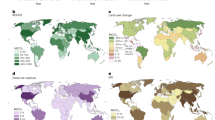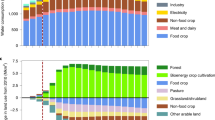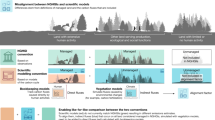Abstract
Under the Paris Agreement, 195 nations have committed to holding the increase in the global average temperature to well below 2 °C above pre-industrial levels and to strive to limit the increase to 1.5 °C (ref. 1). It is noted that this requires "a balance between anthropogenic emissions by sources and removals by sinks of greenhouse gases in the second half of the century"1. This either calls for zero greenhouse gas (GHG) emissions or a balance between positive and negative emissions (NE)2,3. Roadmaps and socio-economic scenarios compatible with a 2 °C or 1.5 °C goal depend upon NE via bioenergy with carbon capture and storage (BECCS) to balance remaining GHG emissions4,5,6,7. However, large-scale deployment of BECCS would imply significant impacts on many Earth system components besides atmospheric CO2 concentrations8,9. Here we explore the feasibility of NE via BECCS from dedicated plantations and potential trade-offs with planetary boundaries (PBs)10,11 for multiple socio-economic pathways. We show that while large-scale BECCS is intended to lower the pressure on the PB for climate change, it would most likely steer the Earth system closer to the PB for freshwater use and lead to further transgression of the PBs for land-system change, biosphere integrity and biogeochemical flows.
This is a preview of subscription content, access via your institution
Access options
Access Nature and 54 other Nature Portfolio journals
Get Nature+, our best-value online-access subscription
$29.99 / 30 days
cancel any time
Subscribe to this journal
Receive 12 print issues and online access
$209.00 per year
only $17.42 per issue
Buy this article
- Purchase on Springer Link
- Instant access to full article PDF
Prices may be subject to local taxes which are calculated during checkout



Similar content being viewed by others
Change history
14 March 2018
In the version of this Letter originally published, in Fig. 2, the labels for the yellow and green areas were swapped: the yellow areas should have been labelled ‘Global uncertainty zones’ and the green areas should have been labelled ‘Global safe zones’. This has now been corrected in the online versions of the Letter.
References
Adoption of the Paris Agreement FCCC/CP/2015/L.9/Rev1 (UNFCCC, 2015).
Rogelj, J. et al. Zero emission targets as long-term global goals for climate protection. Environ. Res. Lett. 10, 105007 (2015).
Sanderson, B. M., O’Neill, B. C. & Tebaldi, C. What would it take to achieve the Paris temperature targets? Geophys. Res. Lett. 43, 7133–7142 (2016).
Rockström, J. et al. A roadmap for rapid decarbonization. Science 355, 1269–1271 (2017).
Fuss, S. et al. Betting on negative emissions. Nat. Clim. Chang. 4, 850–853 (2014).
Gasser, T., Guivarch, C., Tachiiri, K., Jones, C. D. & Ciais, P. Negative emissions physically needed to keep global warming below 2 °C. Nat. Commun. 6, 7958 (2015).
Popp, A. et al. Land-use futures in the shared socio-economic pathways. Glob. Environ. Chang. 42, 331–345 (2017).
Vaughan, N. E. & Lenton, T. M. A review of climate geoengineering proposals. Climatic Change 109, 745–790 (2011).
Heck, V., Gerten, D., Lucht, W. & Boysen, L. R. Is extensive terrestrial carbon dioxide removal a ‘green’ form of geoengineering? A global modelling study. Glob. Planet. Chang. 137, 123–130 (2016).
Rockström, J. et al. A safe operating space for humanity. Nature 461, 472–475 (2009).
Steffen, W. et al. Planetary boundaries: guiding human development on a changing planet. Science 347, 1259855 (2015).
Schleussner, C. F. et al. Science and policy characteristics of the Paris Agreement temperature goal. Nat. Clim. Chang. 6, 827–835 (2016).
Kriegler, E. et al. Fossil-fueled development (SSP5): an energy and resource intensive scenario for the 21st century. Glob. Environ. Chang. 42, 297–315 (2017).
Popp, A. et al. Land-use protection for climate change mitigation. Nat. Clim. Chang. 4, 1095–1098 (2014).
Riahi, K. et al. Glob. Environ. Chang. 42, 153–168 (2017).
Heinke, J. et al. A new climate dataset for systematic assessments of climate change impacts as a function of global warming. Geosci. Model. Dev. 6, 1689–1703 (2013).
Klein, D. et al. The value of bioenergy in low stabilization scenarios: an assessment using REMIND-MAgPIE. Climatic Change 123, 705–718 (2014).
Edenhofer, O. et al. (eds.) Renewable Energy Sources and Climate Change Mitigation (Cambridge University Press, Cambridge, 2011).
Qin, X., Mohan, T., El-Halwagi, M., Cornforth, G. & McCarl, B. A. Switchgrass as an alternate feedstock for power generation: an integrated environmental, energy and economic life-cycle assessment. Clean. Technol. Environ. Policy 8, 233–249 (2006).
National Greenhouse Gas Inventories Programme IPCC Guidelines for National Greenhouse Gas Inventories (IPCC, 2006).
Roncucci, N., Nassi O Di Nasso, N., Tozzini, C., Bonari, E. & Ragaglini, G. Miscanthus giganteus nutrient concentrations and uptakes in autumn and winter harvests as influenced by soil texture, irrigation and nitrogen fertilization in the Mediterranean. Glob. Chang. Biol. Bioenergy 7, 1009–1018 (2015).
Herzog, H. J. Scaling up carbon dioxide capture and storage: from megatons to gigatons. Energy Econ. 33, 597–604 (2011).
Watson, J., Kern, F. & Markusson, N. Resolving or managing uncertainties for carbon capture and storage: Lessons from historical analogues. Technol. Forecast. Soc. 81, 192–204 (2014).
Rogelj, J. et al. Energy system transformations for limiting end-of-century warming to below 1.5 °C. Nat. Clim. Chang. 5, 519–527 (2015).
Smith, P. et al. Biophysical and economic limits to negative CO2 emissions. Nat. Clim. Chang. 6, 42–50 (2016).
Smith, P. et al. How much land-based greenhouse gas mitigation can be achieved without compromising food security and environmental goals? Glob. Chang. Biol. 19, 2285–2302 (2013).
Beringer, T., Lucht, W. & Schaphoff, S. Bioenergy production potential of global biomass plantations under environmental and agricultural constraints. Glob. Chang. Biol. Bioenergy 3, 299–312 (2011).
Bonsch, M. et al. Trade-offs between land and water requirements for large-scale bioenergy production. Glob. Chang. Biol. Bioenergy 8, 11–24 (2014).
Woolf, D. et al. Sustainable biochar to mitigate global climate change. Nat. Commun. 1, 56 (2010).
Gerten, D., Schaphoff, S., Haberlandt, U., Lucht, W. & Sitch, S. Terrestrial vegetation and water balance—hydrological evaluation of a dynamic global vegetation model. J. Hydrol. 286, 249–270 (2004).
Rost, S. et al. Agricultural green and blue water consumption and its influence on the global water system. Water Resour. Res. 44, W09405 (2008).
Sitch, S. et al. Evaluation of ecosystem dynamics, plant geography and terrestrial carbon cycling in the LPJ dynamic global vegetation model. Glob. Chang. Biol. 9, 161–185 (2003).
Bondeau, A. et al. Modelling the role of agriculture for the 20th century global terrestrial carbon balance. Glob. Chang. Biol. 13, 679–706 (2007).
Fader, M., Rost, S., Müller, C., Bondeau, A. & Gerten, D. Virtual water content of temperate cereals and maize: present and potential future patterns. J. Hydrol. 384, 218–231 (2010).
Jägermeyr, J. et al. Water savings potentials of irrigation systems: global simulation of processes and linkages. Hydrol. Earth Syst. Sci. 19, 3073–3091 (2015).
Harris, I., Jones, P., Osborn, T. & Lister, D. Updated high-resolution grids of monthly climatic observations — the CRU TS3.10 Dataset. Int. J. Climatol. 34, 623–642 (2014).
Hastings, A. et al. Future energy potential of Miscanthus in Europe. Glob. Chang. Biol. Bioenergy 1, 180–196 (2009).
Stevanovic, M. et al. The impact of high-end climate change on agricultural welfare. Sci. Adv. 2, e1501452 (2016).
Bodirsky, B. et al. Food demand projections for the 21st century. PLoS. One. 10, e0139201 (2015).
Bodirsky, B. et al. Reactive nitrogen requirements to feed the world in 2050 and potential to mitigate nitrogen pollution. Nat. Commun. 5, 3858 (2014).
Flörke, M. et al. Domestic and industrial water uses of the past 60 years as a mirror of socio-economic development: A global simulation study. Glob. Environ. Chang. 23, 144–156 (2013).
Konis, K. lpSolveAPI: R Interface to ‘lp_solve’ v.5.5.2.0 (2016); https://cran.r-project.org/web/packages/lpSolveAPI/index.html
de Vries, W., Kros, J., Kroeze, C. & Seitzinger, S. P. Assessing planetary and regional nitrogen boundaries related to food security and adverse environmental impacts. Curr. Opin. Environ. Sustain. 5, 392–402 (2013).
Bouwman, L. et al. Exploring global changes in nitrogen and phosphorus cycles in agriculture induced by livestock production over the 1900–2050 period. Proc. Natl Acad. Sci. USA 110, 20882–20887 (2011).
Kauter, D., Lewandowski, I. & Claupein, W. Pflanzenbauwissenschaften 5, 64–74 (2001).
Lassaletta, L., Billen, G., Grizzetti, B., Anglade, J. & Garnier, J. 50 year trends in nitrogen use efficiency of world cropping systems: the relationship between yield and nitrogen input to cropland. Environ. Res. Lett. 9, 105011 (2014).
Scholes, R. J. & Biggs, R. A biodiversity intactness index. Nature 434, 45–49 (2005).
Kier, G. et al. A global assessment of endemism and species richness across island and mainland regions. Proc. Natl. Acad. Sci. USA 106, 9322–9327 (2009).
Pastor, A. V., Ludwig, F., Biemans, H., Hoff, H. & Kabat, P. Accounting for environmental flow requirements in global water assessments. Hydrol. Earth Syst. Sci. 18, 5041–5059 (2014).
Acknowledgements
We thank H. Kreft and C. Meyer for providing the endemism richness data sets and B. Bodirsky for discussions on the planetary boundary for biogeochemical flows. This research was funded by the DFG in the context of the CE-Land and CEMICS2 projects of the Priority Program 'Climate Engineering: Risks, Challenges, Opportunities?' (SPP 1689). We acknowledge the European Regional Development Fund (ERDF), the German Federal Ministry of Education and Research and the Land Brandenburg for supporting this project by providing resources on the high-performance computer system at the Potsdam Institute for Climate Impact Research.
Author information
Authors and Affiliations
Contributions
V.H. designed the study with input from D.G., W.L. and A.P. V.H. developed the methodology, performed all simulations, analysed the results and created the figures. Land-use data from MAgPIE were provided by A.P. V.H. led the writing process with contributions from D.G., W.L. and A.P.
Corresponding author
Ethics declarations
Competing interests
The authors declare no competing financial interests.
Additional information
Publisher’s note: Springer Nature remains neutral with regard to jurisdictional claims in published maps and institutional affiliations.
A correction to this article is available online at https://doi.org/10.1038/s41558-018-0107-z.
Supplementary information
Supplementary Information
Supplementary Methods, Supplementary Tables 1–2, Supplementary Figure 1–7 and Supplementary References.
Rights and permissions
About this article
Cite this article
Heck, V., Gerten, D., Lucht, W. et al. Biomass-based negative emissions difficult to reconcile with planetary boundaries. Nature Clim Change 8, 151–155 (2018). https://doi.org/10.1038/s41558-017-0064-y
Received:
Accepted:
Published:
Issue Date:
DOI: https://doi.org/10.1038/s41558-017-0064-y
This article is cited by
-
Trade-offs in land-based carbon removal measures under 1.5 °C and 2 °C futures
Nature Communications (2024)
-
Exploring negative emission potential of biochar to achieve carbon neutrality goal in China
Nature Communications (2024)
-
Climate change adaptation and mitigation strategies for production forests: Trade-offs, synergies, and uncertainties in biodiversity and ecosystem services delivery in Northern Europe
Ambio (2024)
-
Life cycle assessment and techno-economic analysis of sustainable bioenergy production: a review
Environmental Chemistry Letters (2024)
-
Land-neutral negative emissions through biochar-based fertilization—assessing global potentials under varied management and pyrolysis conditions
Mitigation and Adaptation Strategies for Global Change (2024)



